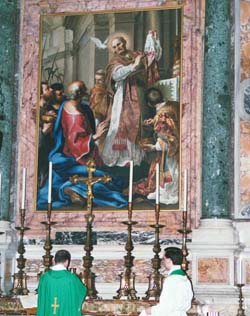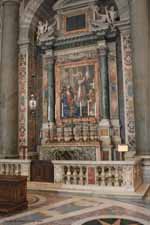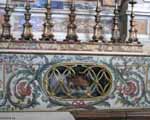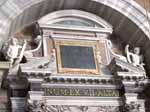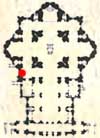
Location in St Peter's
 Altar of St. Gregory the Great (Sep 3, 590 - Mar 12, 604) painting by Sacchi, 1625 |
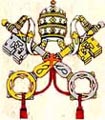 |
| Grottoes
Vatican City Colonnade Saints Floorplan #2 |
| Altars
Monuments The History |
| Related
Items Clementine Chapel |
|
|
From:
'St. Peter's - Guide to the Basilica and Square'
The altar is dedicated to St. Gregory the Great (590-604). In a sarcophagus
beneath the altar his remains are preserved, brought here in 1606. This
Pope, also called the "Savior of the Church" and the "Defender of Rome",
is associated with the name of the Gregorian chant or plainsong which
he promoted. He was also responsible for the evangelization of England.
The splendid mosaic on the altarpiece, after a picture painted in 1625 by Andrea Sacchi (1599-1661), is the work of Alessandro Cocchi and Vincenzo Castellini, and portrays the saint as he shows the faithful cloth stained by the blood which miraculously flowed from the relics of some martyrs.
From:
'St. Peter's Basilica - A Virtual Tour' by Our
Sunday Visitor
Over the altar A. Cochi and V. Castellini executed a mosaic altarpiece
from an original by A. Sacchi, who can be considered the forerunner of
P. Berrettini and the pictorial parallel of A. Algardi, but who also began
that convergence of classicist and Baroque styles, later perfected by
Maratti.
It depicts a "Miracle of St. Gregory Magnus," whose body, first buried in the Popes' Portico in the Old Basilica, was transferred here in 1606, after being moved several times. Before this altar, newly elected Popes received the obedience, before being consecrated and crowned.
This Pope was an eminent figure of the Papacy and its holiness, defining the Pope as "servus servorum," and raising its spiritual standing, after having defended Rome from the menace of annexation by the Longobards.
From
'Guide to Saint Peter's Basilica'
In the splendid mosaic above the altar, one of the most perfect in the
entire basilica, the saint is depicted as showing the faithful a cloth
stained with the blood of martyrs; he encourages them to remain faithful
to Christ and to the commitments of Baptism.
To honor this great person, his tomb is surrounded by the four great Doctors of the Church: Saints Ambrose, Augustine, Athanasius and John Chrysostom, in the mosaic on the dome above the altar.
'The Altars and
Altarpieces of New St. Peter's' by Louise Rice, 1997
The painter depicted the Miraculous Mass of St. Gregory, also known as
the Miracle of the Corporal. In response to a request from the Emperor
Constance for an authentic relic, Gregory gave the emperor's representative
a cloth that had previously been used to wrap the bones of certain martyr
saints (according to another version of the legend, it was the cloth with
which Gregory had wiped the chalice after dispensing the sacrificial wine
during the mass). When the representative rejected the cloth as a paltry
and worthless thing, Gregory, after first saying mass, took it and stabbed
it with a sharp blade, causing it to bleed. The miracle was one of the
most famous involving St. Gregory and was especially popular during the
Catholic Reformation, when it was cited in support of the Catholic position
on the mystical power of relics.
From: 'Lives of
the Popes' by Richard P. McBrien
Only the second pope in all of church history to be called 'the Great'
(Leo I - 440-61 - was the first), Gregory I was the first pope to have
been a monk and was one of the papacy's must influential writers. His
Pastoral Care which defined the episcopal ministry as one of shepherding
souls, became the textbook for medieval bishops.
After accepting consecration as Bishop of Rome under protest (he was unanimously elected), he assumed heavy responsibilities because of the general breakdown of civil order at the time. Gregory found himself drawn as deeply into temporal and political affairs as into spiritual and ecclesiastical concerns. He had been prefect of the city before selling all his possessions, giving he proceeds to the poor, and converting his home into a monastery. As a result of all these efforts, Gregory became virtually the civil as well as spiritual ruler of Rome.
He dispatched Augustine (later of Canterbury) with forty other monks, to England in 596 and later conferred the pallium on Augustine as archbishop of the English.
Given his own monastic background, Gregory was a vigorous promoter of monasticism and of the liturgy, particularly of liturgical music. Indeed, his name was so closely identified with plainsong that it came to be known as Gregorian chant. Many of the prayers recited in the Eucharist are said to be attributed to Gregory. He is also credited with the placement of the "Our Father" in the Mass.
One of his goals was to encourage people to bear the trials of earthly life as a preparation for the eternal life to come. St. Thomas Aquinas cites him 374 times in the second part of the Summa Theologiae. Gregory's own spirituality was marked by a vivid sense of the imminent end of the world, intensified perhaps by the ill health that hindered him throughout his pontificate. He was so racked by gout that, by the time of his death, he could no longer walk.
He was buried in St. Peter's with the epitaph "counsul of God." Feast day: September 3.
